Taiwan Study on Structured Diabetes Education
September 2, 2015
According to an analysis of the 2000– 2009 claims data from Taiwan National Health Insurance (NHI), there was an increase in the prevalence of type 2 diabetes of approximately 70%, from 4.31% in 2000 to 6.38% in 20081.
A study was carried out in two diabetes clinics in Taiwan to look at the impact of structured group education vs. usual care. Details are below, pulled from the Journal of Diabetes Investigation. See the full article here.
ABSTRACT
Aims/Introduction: The purpose of the present study was to examine glycemic control in suboptimally controlled type 2 diabetes provided by a structured diabetes education group using the Diabetes Conversation MapTM (CMTM) vs usual care in a university-based hospital primary care clinic.
Materials and Methods: This was a randomized, pragmatic clinical trial. Patients with type 2 diabetes were randomly assigned to structured education or usual care groups. The primary outcome was the difference in the mean change of glycated hemoglobin (HbA1c) from baseline to 12 months. Secondary outcomes included the percentage achieving therapeutic HbA1c goal and self-behavioral changes.
Results: A total of 245 patients were randomly assigned to two groups (CMTM group n = 121; usual care group, n = 116). The absolute reduction of HbA1c was significantly greater in the CMTM group at 3 and 6 months (D = -0.59% and D = -1.13%, P < 0.01), but the difference was no longer statistically significant at 9 and 12 months (D = -0.43% and D = -0.49%), based on an intention-to-treat analysis. A per-protocol analysis showed the significant change was maintained at 12 months (D = -0.67%). In the intervention group, greater percentages of patients achieved their American Association of Diabetes Educators Self-Care BehavioursTM framework (AADE7) behavioral goals at 3 months, in particular being active, problem-solving, reducing risk and health coping.
Conclusions: In type 2 diabetic patients with suboptimally controlled glucose, there were greater improvements in glucose control and self-care behavioral goals in those who underwent the CMTM education program compared with outcomes achieved in patients receiving usual care.
- Jiang YD, Chang CH, Tai TY, et al. Incidence and prevalence rates of diabetes mellitus in Taiwan: analysis of the 2000–2009 Nationwide Health Insurance database. J Formos Med Assoc 2012; 111: 599– 604.
Other recent news
September 2, 2015
October 17, 2015
July 27, 2015
July 23, 2015
March 23, 2015
